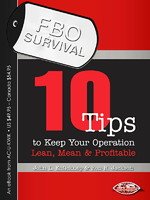By Ron Jackson and John Enticknap, Aviation Business Strategies Group

Welcome to the third installment of our continuing AC-U-KWIK FBO Connection Series: FBO Survival. This series focuses on the various strategies and tactics needed to survive the daily rigors of running a successful FBO operation.
"Your success in life isn't based on your ability to simply change. It is based on your ability to change faster than your competition, customers and business." — Mark Sanborn
For many years, FBOs in the United States have been operated with a simple formula: markup fuel to cover all the operational business expenses. The greater the margin, the better the profit!
When fuel prices were fairly stable and the old inefficient heavy iron aircraft were commonly seen on ramps, this worked out pretty good.
But as singer- songwriter Bob Dylan so poignantly penned, “The Times They are a Changin’”.
From the last quarter of 2008 we’ve seen some real changes in our industry including the political bashing of our industry and a prolonged recession. As we struggled through 2009, we saw the ‘average’ FBO experiencing a 20 to 25 percent drop in business sales – with some losing more than 50 percent of their fuel sales. In 2010/2011 there was some recovery with an encouraging increase in charter activity and the resulting increased fuel sales.
Now in 2013, we are struggling with continuing volatile fuel costs. At the beginning of the year the Gulf Coast Jet A fuel prices ran up to $3.24 per gallon; now they’re down to $2.74 per gallon. That’s a .50 cent swing! Did your posted prices swing .50 cents a gallon?
We are still experiencing more unfortunate politics conveying a negative image for business aviation. And we are seeing the restart of the continued consolidation of the FBO industry – including FBOs that fail. Most of all, FBOs are continuing to experience competitive pressure on fuel margins to include all stakeholders such as customers, contract fuel suppliers and large volume users. Just read about a couple of the large chain operators and the largest corporate aircraft operator in the world – they’re in a dispute over discounts being extended to more corporate aircraft operators.
Changes in Operator Fuel Purchasing Habits
Over the last few years we have seen a strong push from our corporate customers utilizing alternate fuel purchasing strategies, rather than the traditional retail fuel purchase. Of course, the full retail fuel purchase has always been a myth – purchasers of Jet A fuel expect and get discounts off the posted price.
The trend over the last 15 years, especially within the last few, is to pre-negotiate fuel purchasing with many of the contract fuel sellers prior to arriving at your FBO. Calling ahead for the best discount available or changing plans to get the best overall operating costs are all tactics for reduced fuel costs and gallons purchased. This is savvy cost control for corporate operators.
Add to this the fact that corporate aircraft operators are getting more sophisticated in their flight planning:
- Using fuel tankering models
- Pre-established fueling points
- Better ATC routing for weather and flight planning to minimize fuel costs
- The purchase of more fuel-efficient aircraft
FBO Profit Misconceptions
Today’s FBO business model has not changed much over the last 30 years. It is still highly dependent on the retail fuel sale. The successful FBO’s look for the fuel sales – be it retail, contract or other – to essentially support the entire FBO operation.
But do all the aircraft that taxi onto an FBO ramp purchase fuel? No, they don’t. Yet the cost of doing business goes on, including exposing your FBO to potential insurance claims should the customer’s aircraft get mishandled. This has given rise to the Ramp Fee which is still a controversial subject in some aircraft operator’s minds.
Again, there is a misconception by many in the aviation business that FBO’s are super high profitable organizations and, quote: “ripping off” the flying public. This, of course, is highly exaggerated.
Changes in the Wind
However, the FBO business model in the U.S., as we know today, is destined for change. As mentioned, fuel margins are being squeezed from both ends. At one end is the volatile cost of fuel which drives significant base price changes. At the other end is the more savvy aircraft operator trying to drive down the sale price. In the middle is your margin, being squeezed like a lemon in a juice press.
So, how do we make lemonade out of the tart extracted juice? Here are few observations to ponder …
Having operated FBOs in both the U.S. and in the Middle East, we are very familiar with the European FBO Business model where fuel is not part of the income equation. Rather, fixed base operators in this part of the world depend on revenue generated solely by fees associated with providing various services common to an FBO operation:
- Marshalling
- Handling
- Parking
- Ramp
- Ramp transportation
- Over the Road transportation
- Baggage Handling
- GPU
- Lavatory Service
- Customs/visa
- A handling fee for collecting navigation fees
- A handling fee for collecting landing and over-flight fees
- Lounge Fees
- Catering
We are not suggesting you should follow this model, at least in its entirety. However, as margins get squeezed, you need to get creative in shoring up your bottom line by creating other streams of income.
Don’t Give it Away!
So our FBO Survival advice for this blog post is: DON’T GIVE IT AWAY!
If a customer doesn’t buy fuel, or at least doesn’t buy a minimum quantity for the type of aircraft being flown, why not charge a facility fee for use of the ramp that includes labor for safely parking and towing the aircraft, and repositioning for passenger loading?
If aircraft operators want a significant discount off the posted price, why not charge for taking out the trash, cleaning the lav, servicing the galley with ice and coffee or hooking up the APU?
If a fuel broker drives a hard bargain, why not charge for the courtesy vehicle or the newspapers? This often entails a requested set for the pilots and a set for the passengers.
If, during the course of a transaction, your fuel margin is significantly compromised in any way, why not consider an Airport Infrastructure Fee; say $18.88 per aircraft for all transient aircraft, for that clean restroom which is kept tidy by paid staff? Or how about a fee to cover the nicely furnished and well equipped conference room, pilot and customer lounges, the coffee and cookie bar which is kept well stocked throughout the day?
No, were not saying you need or want to charge for everything you do, but you need to analyze your various income streams and make sure you’re not giving your services away. Your business deserves to make a profit – and that is not a bad word! Your business should not subsidize corporate aircraft operating companies or your airport sponsor. If you do that, your business will not survive and you’ll lose your investment. Profit, it allows for growth and the continuation of your business.
If you like this series, please ‘like’ us by clicking the icon below. Also, let us know your thoughts by e-mailing us at:
John Enticknap: jenticknap@bellsouth.net
Ron Jackson: rjacksongroup@earthlink.net
About the authors:
Ron Jackson
Ron Jackson is Co-Founder of Aviation Business Strategies Group and President of The Jackson Group, a PR agency specializing in FBO marketing and CSR training. He has held management positions with Cessna Aircraft and Bozell Advertising and is the author of “Mission Marketing: Creating Brand Value” and co-author of “Don’t Forget the Cheese!” the ultimate FBO Customer Service Experience. Ron co-developed NATA’s acclaimed FBO Success Seminar Series and writes an industry blog for AcUKwikAlert.com titled: The FBO Connection.
John Enticknap
John Enticknap founded Aviation Business Strategies Group in 2006 following a distinguished career in aviation fueling and FBO management, including President of Mercury Air Centers network of 21 FBO locations. He is an ATP and CFI rated pilot with more than 7,800 flight hours and is the author of “10 Steps to Building a Profitable FBO”. John developed NATA’s acclaimed FBO Success Seminar Series and writes an industry blog for AcUKwikAlert.com titled: The FBO Connection.
There is nothing more difficult to take in hand, more perilous to conduct, or more uncertain in its success, than to take the lead in the introduction of a new order of things




















